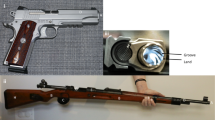Abstract
Gunshot wounds (GSWs) are an important cause of disability and death in the USA. Although radiography is limited in its ability to detect bullet types, a projectile introduced during the last decade, the R.I.P. bullet by G2 Research, consists of a base slug connected to 6 to 8 sharp trocars designed to diverge within soft tissue following impact, resulting in what we believe to be a unique imaging appearance that can be confusing to those not familiar with this particular projectile. Furthermore, this bullet is 100% copper, which may allow for safe imaging with magnetic resonance imaging if correctly identified prior to scanning.





Similar content being viewed by others
References
Fowler KA, Dahlberg LL, Haileyesus T, Annest JL. Firearm injuries in the United States. Prev Med. 2015;79:5–14.
Chicago Police Department 2018 Annual Report. http://home.chicagopolice.org/wp-content/uploads/2019/07/2018AnnualReport-05July19.pdf, accessed Mar 29, 2020.
Pinto A, Russo A, Reginelli A, Iacobellis F, De Serafino M, Giovine S, et al. Gunshot wounds: ballistics and imaging findings. Semin Ultrasound CT MR. 2018;40:25–35.
Hollerman JJ, Fackler ML. Gunshot wounds: radiology and wound ballistics. Emerg Radiol. 1995;2(4):171–92.
Rhee PM, Moore EE, Joseph B, Tang A, Pandit V, Vercruysse G. Gunshot wounds: a review of ballistics, bullets, weapons, and myths. J Trauma Acute Care Surg. 2016;80(6):853–67.
The ATFE Training and Standardization Committee, editor. Glossary of the Association of Firearm and Tool Mark Examiners. 4th ed: Montreal: Forensic Technology, Incorporated; 2002.
Hanna TN, Shuaib W, Han T, Mehta A, Khosa F. Firearms, bullets, and wound ballistics: an imaging primer. Injury Int J Care Injured. 2015;46:1186–96.
Prat NJ, Daban JL, Voiglio EJ, Rongieras F. Wound ballistics and blast injuries. J Visc Surg. 2017;154:S9–S12.
Carr DJ, Stevenson T, Mahoney PF. The use of gelatin in wound ballistics research. Int J Legal Med. 2018;132:1659–64.
Stefanopoulos PK, Filippakis K, Soupiou OT, Pazarakiotis VC. Wound ballistics of firearm-related injuries – part 1: missile characteristics and mechanisms of soft tissue wounding. Int J Oral Maxillofac Surg. 2014;43:1445–58.
Bartlett CS. Clinical update: gunshot wound ballistics. Clin Orthop Relat Res. 2003;408:28–57.
G2 Research. https://g2rammo.com/handgun-ammunition, accessed Mar 29, 2020.
Giorgetti A, Giraudo C, Viero A, et al. Radiological investigation of gunshot wounds: a systematic review of published evidence. Int J Legal Med. 2019:133–1149-58.
Dedini RD, Karacozoff AM, Shellock FG, Xu D, McClellan RT, Pekmezci M. MRI issues for ballistic objects: information obtained at 1.5-, 3- and 7-Tesla. Spine J. 2013;13:815–22.
Ditkofsky N, Maresky HS, Steenburg S. Radically invasive projectiles—first reports and imaging features of this new and dangerous bullet. Emerg Radiol. Published online: 04 March 2020 https://doi.org/10.1007/s10140-020-01766-5 accessed 05 May 2020.
Iverson KR, Curtis E, Brown IE, Salcedo ES, Anderson JT. New fragmenting bullet leads to unexpected injury pattern: a case report involving the radically invasive projectile. Trauma. 2019;21(1):73–6.
Hakki L, Smith A, Babin J, Hunt J, Duchesne J, Greiffenstein P. Effects of a fragmenting handgun bullet: considerations for trauma care providers. Injury. 2019;50(5):1143–6.
Acknowledgments
The authors would like to thank Joseph Keating, Section Chief of the Forensic Firearm Laboratory of the Chicago Police Department, for providing examples of the G2 Research R.I.P. bullet as well as advice.
Author information
Authors and Affiliations
Corresponding author
Additional information
Publisher’s note
Springer Nature remains neutral with regard to jurisdictional claims in published maps and institutional affiliations.
Rights and permissions
About this article
Cite this article
Stacy, G.S., Thomas, S. The G2 research R.I.P. fragmenting bullet—radiographic features of a recently encountered projectile. Skeletal Radiol 49, 1663–1668 (2020). https://doi.org/10.1007/s00256-020-03486-w
Received:
Revised:
Accepted:
Published:
Issue Date:
DOI: https://doi.org/10.1007/s00256-020-03486-w




